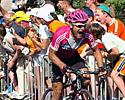
Recently on Cyclingnews.com |
View from the lab - Ric Stern's Tour de France sports science
|
|
British ABCC coach Ric Stern (www.cyclecoach.com) is a regular contributor to Cyclingnews' Form & Fitness section along with being a full time coach. Still an active rider when time allows, Ric will be providing a physiological insight into the challenges that face the riders in the Tour.
July 5, 2006: Kessler does it!

|
Bravo! Excellent! 10 out of 10! If at first you don't succeed, try, try again. With just two kilometres to go in the third stage Matthias Kessler (T-Mobile) attacked perfectly on the Cauberg climb in Holland. He then powered away from the remaining riders and rode solo to the finish. Bravo!
So, how did he get away? Very likely he powered up the climb at above both his TTpower and his MAP. The climb was short, and therefore he could really power along. Most likely he would have been close to maximum heart rate up the Cauberg and at least some of the way down to the finish.
Why did he stay away today, and not yesterday? One reason is that the distance from the summit to the finish wasn't far, and thus it would have been difficult to organise a cohesive chase in the final metres. This is an important lesson that you should do prior to racing: are there any good attacking points that are close to the finish? If there’s a climb approaching the finish or you're inside the last couple of kilometres and you can't sprint – take a chance. It sometimes pays off.
Additionally, with the fatigue that the riders will already be building up and the heat of the stage this may have also affected the chasers.

|
It was hot yesterday in Holland, and as I mentioned on stage 1 fluid intake would have been critical. But how much should you drink?
There’s a couple of ways of estimating your fluid needs (although they may not always be practical). By subtracting your post exercise mass, from your pre exercise mass and accounting for fluid intake you can get an idea of your fluid requirements for the future and how much you need to drink post exercise to rehydrate.
Record your nude mass directly prior to exercise (e.g. 70 kg).
Finish the training/race, strip and towel yourself dry. Record your post exercise nude mass (e.g. 67 kg).
Record exercise duration (e.g. 5 hours).
Record fluid consumed during exercise (e.g., 5 bottles of 500 mL = 2.5 litres; each litre weighs approximately 1 kg).
Calculation would be as follows:
70 – 67 = 3 kg (pre minus post exercise mass = fluid loss)
3 kg + 2.5 L (kg) = 5.5 kg (fluid loss plus fluid intake = total fluid loss)
5.5 kg / 5 hours = 1.1 L/hour (total fluid loss divided by exercise time = sweat
rate in litres per hour).
Therefore, with the above illustration we can see that this imaginary rider requires ~ 1.1 L of fluid per hour to remain hydrated. In practical terms, it may not be possible to drink the required volume. If you have a shortfall (i.e., you weigh less after exercise than before) then you should drink 150% of the fluid deficit. It should be a carbohydrate-electrolyte drink. If you use plain water, you'll end up peeing it straight out again. The salts help retain the fluid.
Another method of determining whether or not you're dehydrated is the pee test. Generally, when you urinate it should be a straw colour, and if it’s darker than this it’s likely that you are tending towards dehydration. Remember that small changes in body mass (and thus becoming dehydrated) will slow you down significantly. Large changes in body mass can be potentially life threatening. On the other hand if you drink lots of non-electrolyte fluids (e.g. water) this can cause the very serious condition of hyponatraemia – water intoxication, which can also be fatal.
Okay, some training tips. How can you get a good jump on the peloton for forcing a gap? Firstly, it’s important to realise that you shouldn't underestimate the usefulness of just increasing your MAP and TTpower so that you can ride at a higher power, but for the actual attacking. I suggest two types of 30-second intervals:
1) 30-secs on and 30-secs off (around zone 7). Three to five in a set and with around 10-minutes between sets, and several plus sets. You'll find that power will tend to decline as you complete more and more intervals
2) 30-sec intervals again this time ‘all-out’ and with a big recovery period between intervals – around five to ten minutes. Stop the session when your power starts to decline
I'm betting on a sprint finish for stage 4!

